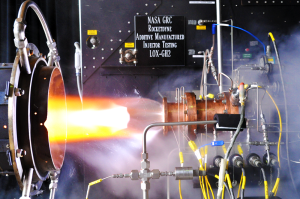On June 23, Aerojet Rocketdyne, manufacturer of rockets and missile propulsion systems, performed a series of hot-fire tests on a Bantam demonstration engine that was made entirely with 3D printing. Best of all, the engine, which will help the GenCorp company develop more cost-effective engines for booster, upper-stage, and in-space propulsion, passed those tests successfully.

Director of Advanced Launch Propulsion Programs at Aerojet Rocketdyne, Jay Littles, explains that this rocket wasn’t only partially made with additive manufacturing, it was completely 3D printed, “The demonstration of this engine, made completely with additive manufacturing, is another significant milestone in our path to changing propulsion affordability. We are not just making a stand-alone chamber or injector derived from traditional design approaches. Rather, we are integrating the full capability of additive manufacturing processes to evolve a proven, reliable, affordable design. We are doing so with technical depth and rigor to meet our unparalleled quality and safety requirements.”
By additively manufacturing aerospace components such as the Bantam engine, manufacturers can create complex, efficient designs, while reducing the number of separate moving parts. This engine, for instance, is normally made up of dozens of parts, but, in the case of the 3D printed upgrade, there are only three separate components: the combination injector and dome assembly, the combustion chamber, and a combination throat and nozzle section. Adapting a proven design of the Atlas Sustainer engine, the Aerojet Rocketdyne team was able to reduce design and manufacturing time from over a year to a couple of months. Additionally, the cost of the engine was brought down a stunning 65%
This 3D printed Baby Bantam – standing at the lower end of the Bantam family’s thrust range – uses liquid oxygen and kerosene to produce a thrust of 5,000 pounds, compared to the farthest thrust ranging engines, which use various fuels to thrust up to 200,000 pounds. As a part of the aerospace and defense contractor’s ongoing study into the possibility of producing engines with 3D printing, we may even see these farther thrusting engines produced with the technology.
Source: Marketwatch



